Charring of and Chemical Changes in Historical Wood under Thermal Loading
Abstract
:1. Introduction
2. Material and Methods
2.1. Microscopic Observation of the Historical Wood Sample
2.2. Medium-Scale Test for Assessing the Depth of Charring
2.3. Color Changes
2.4. Chemical Analyses
2.4.1. Determination of Extractives
2.4.2. Determination of Holocellulose and Lignin
2.4.3. FTIR Analysis of Wood and Holocellulose
2.5. Determination of Heat of Combustion
- QCV—calorific value upon constant volume and water content w (kJ∙kg−1);
- QHC—the heat of combustion upon constant volume and waterless state (kJ∙kg−1);
- w(H)—hydrogen percentage content (6.01% for wood);
- w—the relative moisture content (%).
3. Results and Discussion
3.1. Microscopic Observation of Historical Wood Samples
3.2. Medium-Scale Test for Assessing the Depth of Charring
3.3. Char Layer and Color Changes
3.4. Chemical Composition of Pine Wood
3.5. Calorimetry
3.6. FTIR Analysis of Pine Wood
4. Conclusions
- -
- The insulating character of the charred layer created was confirmed;
- -
- With increasing distance from the exposed side, the rate of charring decreases;
- -
- The charring temperature is approx. 300 °C, based on a visual assessment of the cross-sectional test sample and adequate temperature curves;
- -
- The charring process of historical wood is significantly faster than the charring of current wood. This fact is confirmed by comparing the results of the medium-scale test for historical wood with the results of other authors [13] for current wood;
- -
- The relative content of extractives decreased with the increasing temperature due to their degradation;
- -
- The relative holocellulose content decreased with the increasing temperature due to the degradation of saccharides of the hemicellulose type;
- -
- The relative content of lignin increased with the increasing temperature, which may have been caused by the condensation reactions of lignin with hemicelluloses cleavage products or lignin macromolecule cross-linking;
- -
- There was a polynomial correlation between the heat of combustion and the content of extractives, a negative correlation between the heat of combustion and holocellulose, and a positive correlation between the heat of combustion and lignin;
- -
- FTIR analysis confirmed the degradation of hemicelluloses, condensation reactions of lignin, and increase in cellulose crystallinity, while all wood components were degraded at a temperature above 550 °C.
Author Contributions
Funding
Data Availability Statement
Conflicts of Interest
References
- Chorlton, B.; Gales, J. Fire performace of cultural heritage and contemporary timbers. Eng. Struct. 2019, 201, 109739. [Google Scholar] [CrossRef]
- Yin, Y.; Luo, B.; Zhang, Z.; Zhang, Y.; Cheng, X.; Jiang, X. Introductione to the application of non-destructive testing methods in wood structure ancient architecture. ANc. Archit. Gard. Technol. 2020, 3, 20–23. [Google Scholar]
- Kučerová, V.; Lagaňa, R.; Hýrošová, T. Changes in chemical and optical properties of silver fir (Abies alba L.) wood due to thermal treatment. J. Wood Sci. Vol. 2019, 65, 21. [Google Scholar] [CrossRef]
- Zaman, A.; Alen, R.; Kotilainen, R. Thermal behavior of scots pine (Pinus sylvestris) and silver birch (Betula pendula) at 200–230 °C. Wood Fiber Sci. 2000, 32, 138–143. [Google Scholar]
- Friquin, K.L. Material properties and external factors influencing the charring rate of solid wood and glue-laminated timber. Fire Mater. 2011, 35, 303–327. [Google Scholar] [CrossRef]
- Jang, E.S.; Kang, C.W. Changes in gas permeability and pore structure of wood under heat treating temperature conditions. J. Wood Sci. 2019, 65, 37. [Google Scholar] [CrossRef]
- Zawadzki, J.; Gawron, J.; Antczak, A.; Klosińska, T.; Radomski, A. The influence of heat treatment on the physico-chemical properties of pinewood (Pinus sylvestris L.). Drewno 2016, 59, 49–57. [Google Scholar] [CrossRef]
- Taghiyari, H.R.; Bayani, S.; Militz, H.; Papadopoulos, A.N. Heat Treatment of Pine Wood: Possible Effect of Impregnation with Silver Nanosuspension. Forests 2020, 11, 466. [Google Scholar] [CrossRef]
- Piernik, M.; Woźniak, M.; Pinkowski, G.; Szentner, K.; Ratajczak, I.; Krauss, A. Impact of the Heat Treatment Duration on Color and Selected Mechanical and Chemical Properties of Scots Pine Wood. Materials 2022, 15, 5425. [Google Scholar] [CrossRef]
- Candelier, K.; Thevenon, M.F.; Petrissans, A.; Dumarcay, S.; Gerardin, P.; Petrissans, M. Control of wood thermal treatment and its effects on decay resistance: A review. Ann. For. Sci. Vol. 2016, 73, 571–583. [Google Scholar] [CrossRef]
- Durmaz, E.; Ucuncu, T.; Karamanoglu, M.; Kaymakci, A. Effects of heat treatment on some characteristics of Scots pine (Pinus sylvestris L.) wood. FioResources 2019, 14, 9531–9543. [Google Scholar] [CrossRef]
- Peng, Q.; Ormondroyd, G.; Spear, M.; Chang, W.S. The effect of the changes in chemical composition due to thermal treatment on the mechanical properties of Pinus densiflora. Constr. Build. Mater. 2022, 358, 129303. [Google Scholar] [CrossRef]
- Fonseca, E.M.; Barreira, L.M.S. Charring rate determination of wood pine profiles submitted to high temperatures. WIT Trans. Built Environ. 2009, 108, 449–459. [Google Scholar]
- Lipinskas, D.; Mačiulaitis, R. Further opportunities for development of the method for fire origin prognosis. J. Civ. Eng. Manag. 2005, 9, 299–307. [Google Scholar] [CrossRef]
- White, R.H.; Dietenberger, M.A. Fire safety of wood construction. In Wood Handbook; Wood as an engineering material; General Technical Report: Madison, WI, USA, 2010; pp. 18–22. [Google Scholar]
- Dietenberger, M.; Hasburgh, L. Wood Products Thermal Degradation and Fire. In Reference Module in Materials Science and Materials Engineering; Elsevier: Amsterdam, The Netherlands, 2016; pp. 9712–9716. [Google Scholar]
- Esteves, B.M.; Sen, U.; Pereire, H. Influence of Chemical Composition on Heating Value of Biomass: A Review and Bibliometric Analysis. Energies 2023, 16, 4226. [Google Scholar] [CrossRef]
- Blass, H.J. Timber Engineering: Step 1: Basic of Design, Material Properties, Structural Components and Joints; Centrum Hout: Almere, The Netherlands, 1995; p. 300. [Google Scholar]
- EN 1995-1-2:2004/AC:2009; Eurocode 5: Design of Timber Structures-Part 1-2: General-Structural Fire Design. European Union: Brussels, Belgium, 2009.
- Esteves, B.M.; Pereira, H.M. Wood modificatiion by heat treatment: A review. Bioresurces 2008, 4, 370–404. [Google Scholar] [CrossRef]
- Konig, J. Structural fire design according to Eurocode 5—Design rules and their background. Fire Mater. 2004, 29, 147–163. [Google Scholar] [CrossRef]
- Mikkola, E. Charring of wood based materials. Fire Saf. Sci. 1991, 3, 547–556. [Google Scholar] [CrossRef]
- Harper, C.A. Handbook of Building Materials for Fire Protection (e-Book); McGraw-Hill: New York, NY, USA, 2004. [Google Scholar]
- Su, H.C.; Tung, S.F.; Tzeng, C.T.; Lai, C.M. Variation in the charring depth of wood studs inside wood-frame walls with time in a fire. Wood Res. 2019, 64, 449–460. [Google Scholar]
- Pinto, E.M.; Machado, G.O.; Felipetto, R.P.; Chistoforo, A.L.; Lahr, F.A.R.; Calil, C.J. Thermal Degradation and Charring Rate of Corymbia Citriodora. Open Constr. Build. Technol. J. 2016, 10, 450–456. [Google Scholar]
- Li, K.; Hostikka, S.; Peng, D.; Yuanzhou, L.; Heping, Z.; Jie, J. Charring shrinkage and cracking of fir during pyrolysis in an inert atmosphere and at different ambient pressures. Proc. Combust. Inst. 2017, 36, 3185–3194. [Google Scholar] [CrossRef]
- Li, K.; Mousavi, M.; Hostikka, S. Char cracking of medium density fibreboard due to thermal shock effect induced pyrolysis shrinkage. Fire SAfety J. 2017, 91, 165–173. [Google Scholar] [CrossRef]
- Tardif, J.C.; Conciatori, F. Microscopis Exmination of Wood: Sample Preparation and Techniques for Light Microscopy; Springer: Cham, Switzerland, 2015; pp. 373–415. [Google Scholar]
- Jones, B.; Tardif, J.; Westwood, R. Weekly xylem production in trembling aspen (Populus tremuloides) in response to artificial defoliation. Can. J. Bot. 2004, 82, 590–597. [Google Scholar] [CrossRef]
- Heinrichs, D.K.; Tardif, J.C.; Bergeron, Y. Xylem production in six tree species growing on an island in the boreal forest region of western Quebec, Canada. Can. J. Bot. 2007, 85, 518–525. [Google Scholar] [CrossRef]
- Waito, J.; Conciatori, F.; Tardif, J.C. Frost Rings and White Earlywood Rings in Picea Mariana trees from the boreal plains, Central Canada. IAWA J. 2013, 34, 71–87. [Google Scholar] [CrossRef]
- Au, R.; Tardif, J.C. Allometric relationships and dendroecology of the dwarf shrub Dryas integrifolia near Churchill, subarctic Manitoba. Can. J. Bot. 2007, 85, 585–597. [Google Scholar] [CrossRef]
- Le, T.D.; Thasi, M.T. Experimental Assessment of the Fire Resistance. Materials 2019, 12, 4003. [Google Scholar] [CrossRef]
- Buchanan, A.H.; Abu, A.K. Structural Design for Fire Safety, 2nd ed.; Wiley: Dunedin, FL, USA, 2017. [Google Scholar]
- ASTM D1106-96; Standard Test Method for Acid-Insoluble Lignin in Wood. ASTM International: West Conshohocken, PA, USA, 2017.
- Wise, L.E.; Murphy, M.; Adieco, A.D.D. Chlorite holocellulose, its fractionnation and bearing on summative wood analysis and on studies on the hemicelluloses. Pap. Trade J. 1946, 122, 35–43. [Google Scholar]
- ASTM D1107-96; Standard Test Method for Ethanol-Toluene Solubility of Wood. ASTM International: West Conshohocken, PA, USA, 2007.
- Nelson, M.L.; O’Connor, R.T. Relation of certain infrared bands to cellulose crystallinity and crystal latticed type. Part I. Spectra of lattice types I, II, III and of amorphous cellulose†. J. Appl. Polym. Sci. 1964, 8, 1311–1324. [Google Scholar] [CrossRef]
- STN ISO 1928:2003-07; Solid Fuels. Determination of Gross Caloric Value and Calculation of Heating. ISO: Geneva, Switzerland, 2003.
- Wang, Y.; Wang, W.; Zhou, H.; Qi, F. Burning characteristics of ancient wood from traditional buildings in Shanxi Province. Forests 2022, 13, 190. [Google Scholar] [CrossRef]
- Hadvig, S. Charring of Wood in Buildings Fire: Practice, Theory, Instrumentation, Measurement; Technical University in Denmark: Lyngby, Denmark, 1981; p. 238. [Google Scholar]
- Martinka, J.; Rantuch, P.; Liner, M. Calculation of charring rate and char depth of spruce and pine wood from mass loss. J. Therm. Anal. Calorim. 2018, 132, 1105–1113. [Google Scholar] [CrossRef]
- Waliszewska, B.; Prądzyński, W.; Zborowska, A.; Stachowiak-Wencek, A.; Waliszewska, H.; Spek-Dźwigała, A. The diversification of chemical composition of pine wood depending on the. For. Wood Technol. 2015, 91, 182–187. [Google Scholar]
- Campbell, A.G.; Kim, W.-J.; Koch, P. Chemical Variation in Lodgepole Pine with Sapwood/Heartwood, Stem Height, and Variety. Wood Fiber Sci. 1990, 22, 22–30. [Google Scholar]
- Nuopponene, M.; Vuorinen, T.; Jämsä, S.; Viitaniemi, P. Thermal Modifications in Softwood Studied by FT-IR and UV Resonance Raman Spectroscopies. J. Wood Chem. Technol. 2005, 24, 13–26. [Google Scholar] [CrossRef]
- Boonstra, M.J.; Tjeerdsma, B. Chemical analysis of heat treated softwood. Holz Roh- Werkst. 2006, 64, 204–211. [Google Scholar] [CrossRef]
- Esteves, B.; Videira, R.; Pereira, H. Chemisty analysis of heat treated pine wood extractives. Wood Sci. Technol. 2011, 45, 661–667. [Google Scholar] [CrossRef]
- Mbakidi-Ngouaby, H.; Pinault, E.; Gloaguen, V.; Costa, G.; Sol, V.; Millot, M.; Mambu, L. Profiling and seasonal variation of chemical constituents from Pseudotsuga menziesii wood. Ind. Crops Prod. 2018, 117, 34–49. [Google Scholar] [CrossRef]
- Dorez, G.; Ferry, L.; Sonnier, R.; Taguet, A.; Lopez-Cuesta, J.M. Effect of cellulose, hemicellulose and lignin contents on pyrolysis and combustion of natural. J. Anal. Appl. Pyrolysis 2014, 107, 323–331. [Google Scholar] [CrossRef]
- Kim, D.; Park, K.Y.; Yoshikawa, K. Conversion of Municipal Solid Wastes into Biochar through Hydrothermal Carbonization. In Engineering Applications of Biochar; InTechOpen: London, UK, 2017. [Google Scholar]
- Demirbas, A. Higher heating values of lignin types from wood and non-wood lignocellulosic biomasses. Energy Sources 2017, 39, 592–598. [Google Scholar] [CrossRef]
- Maksimuk, Y.; Antonava, Z.; Krouk, V.; Korsakava, A.; Kursevich, V. Prediction of Higher Heating Value Based on Elemental Composition for Lignin and Other Fuels. Fuel 2020, 263, 116727. [Google Scholar] [CrossRef]
- Srinivas, K.; Pandey, K.K. Photodegradation of thermally modified wood. J. Photochem. Photobiol. B Biol. 2012, 117, 140–145. [Google Scholar] [CrossRef] [PubMed]
- Kotilainen, R.A.; Toivanen, T.-J.; Alén, R.J. FTIR Monitoring of Chemical Changes in Softwood During Heating. J. Wood Chem. Technol. 2000, 20, 307–320. [Google Scholar] [CrossRef]
- Michell, A.; Higgins, H. Infrared Spectroscopy in Australian Forest Products Research; CSIRO Forestra and Forest Products: Melbourne, Australia, 2002; p. 60. [Google Scholar]
- Özgenç, Ö.; Durzam, S.; Boyc, I.H.; Eski-Kocak, H. Determination of chemical changes in heat-treated wood using ATR-FTIR and FT Raman spectrometry. Spectrochim. Acta Part A Mol. Biomol. Spectrosc. 2017, 17, 395–400. [Google Scholar] [CrossRef] [PubMed]
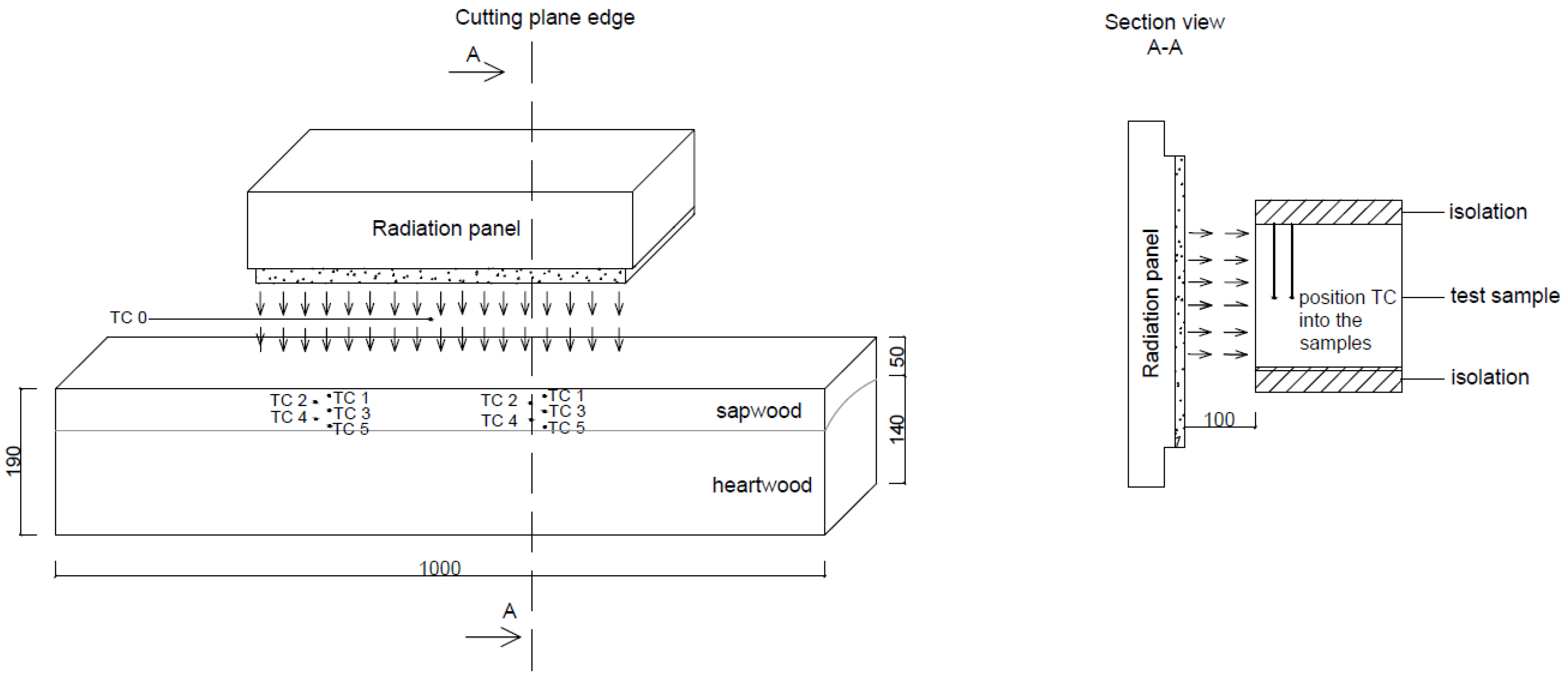

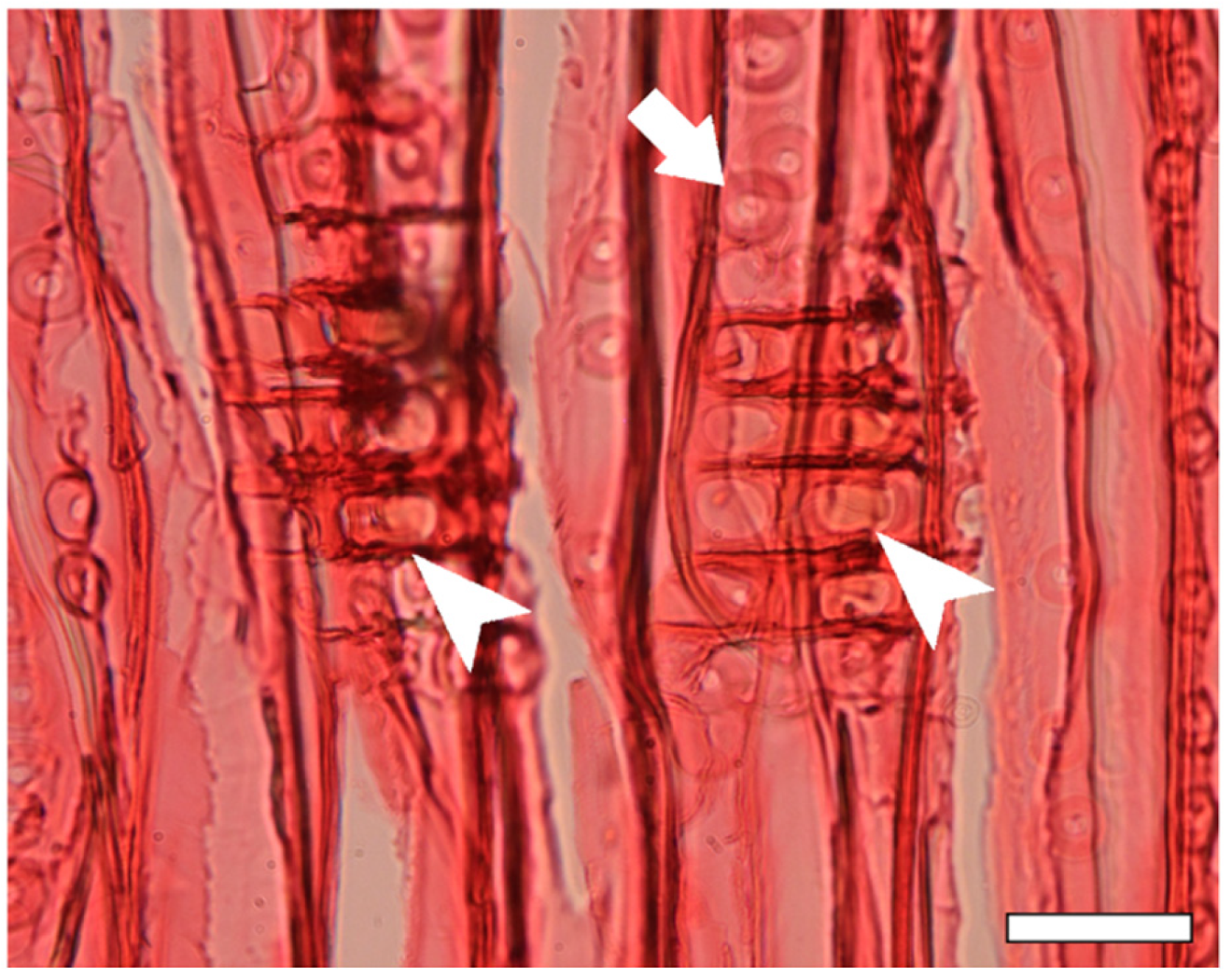
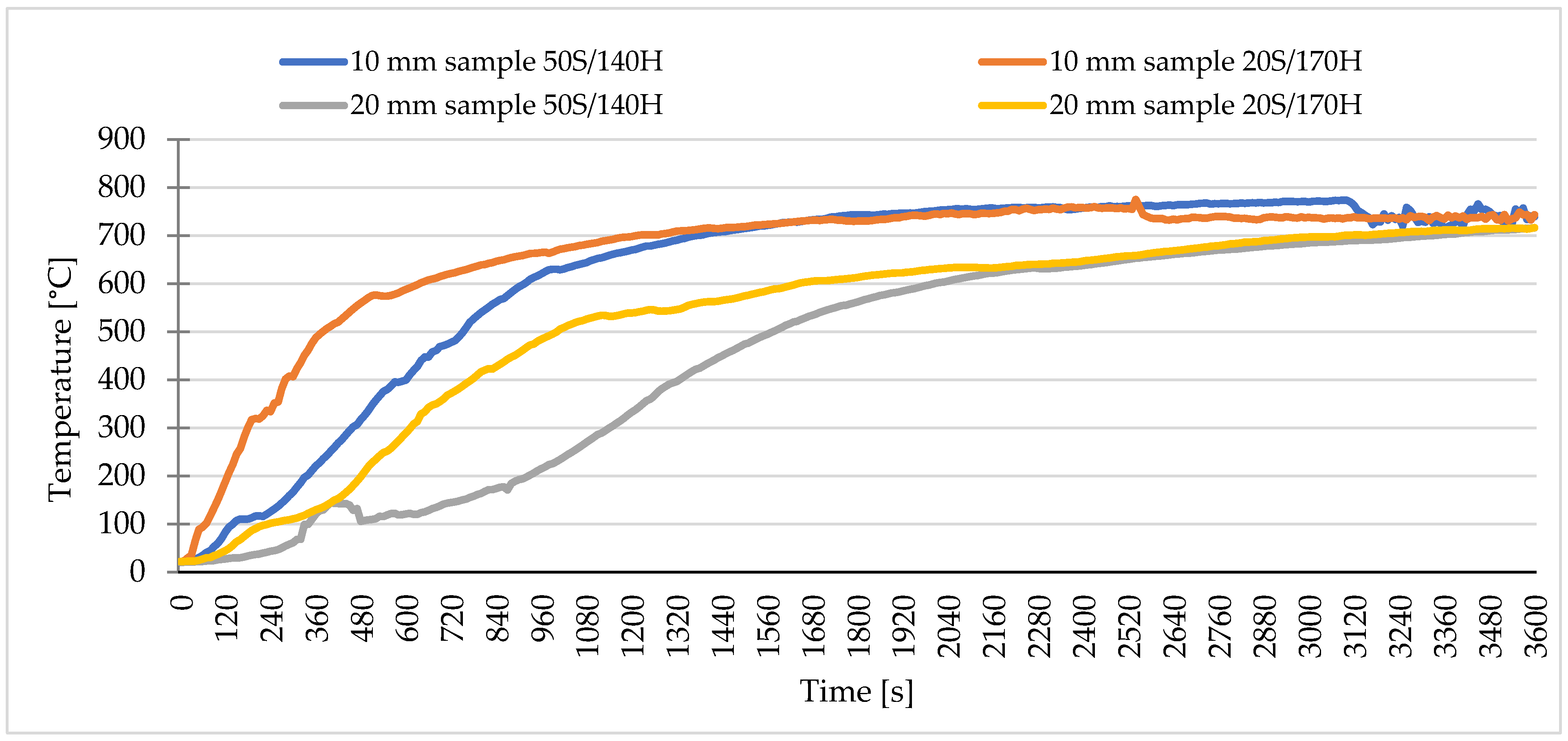

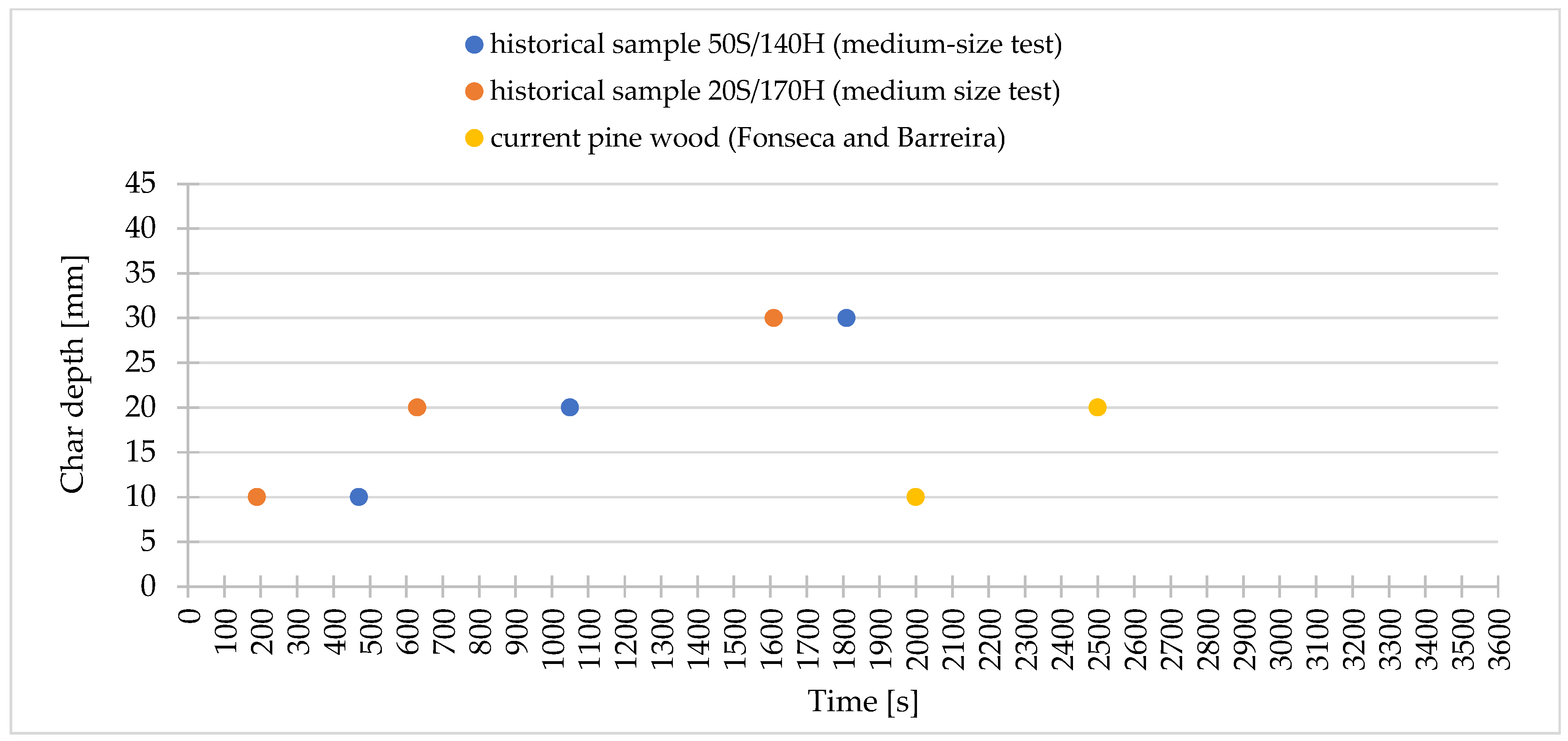
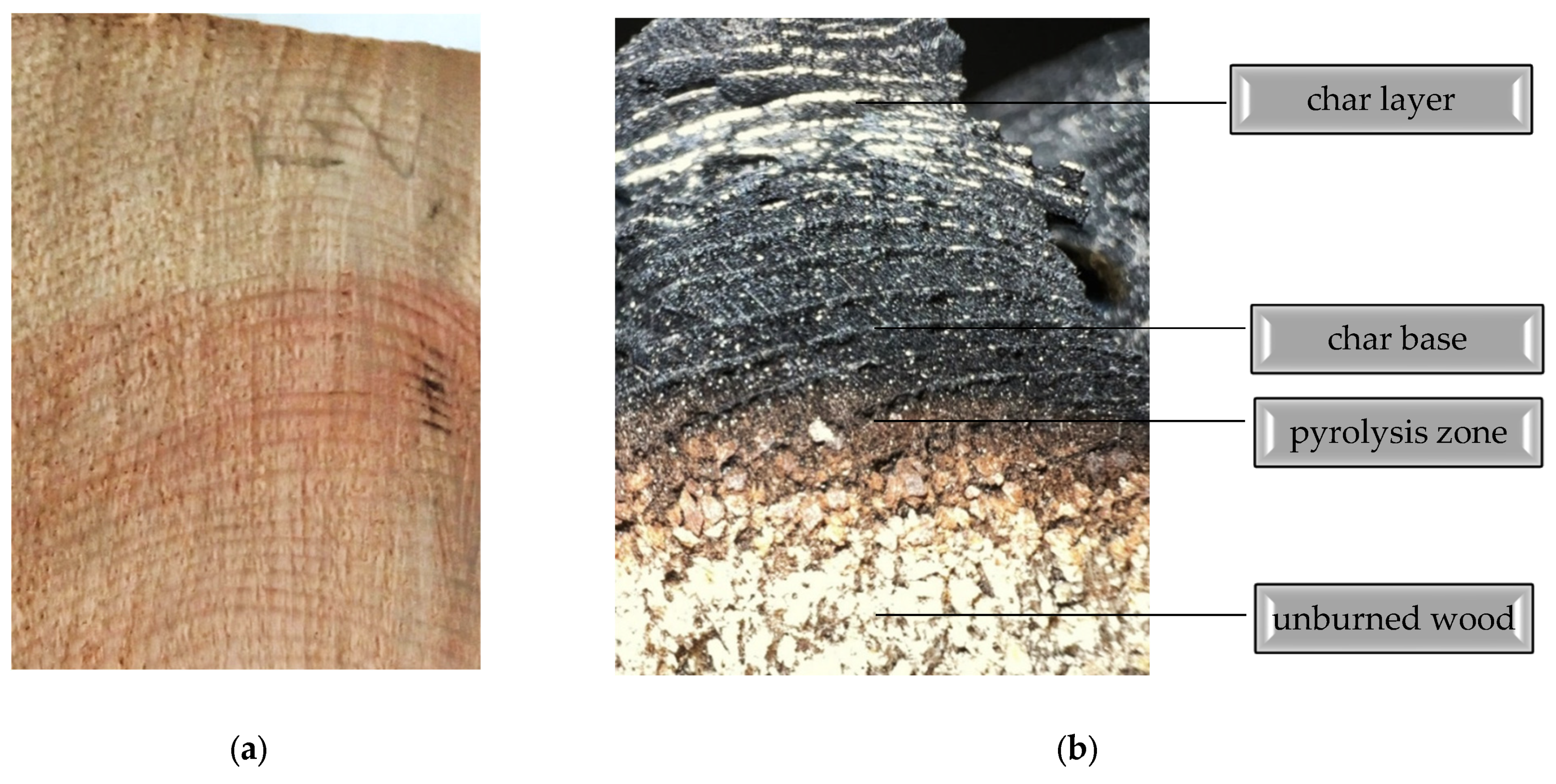
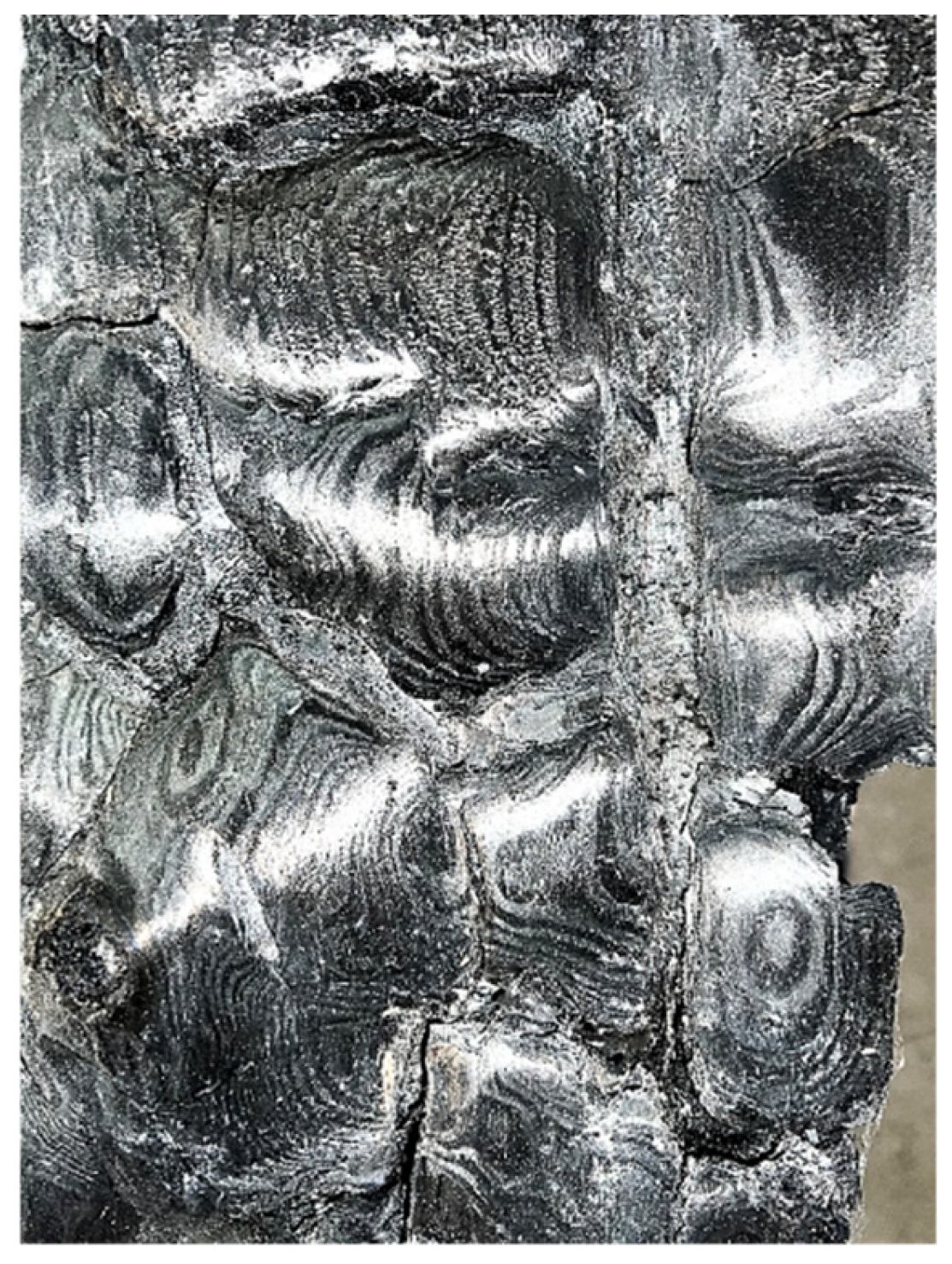
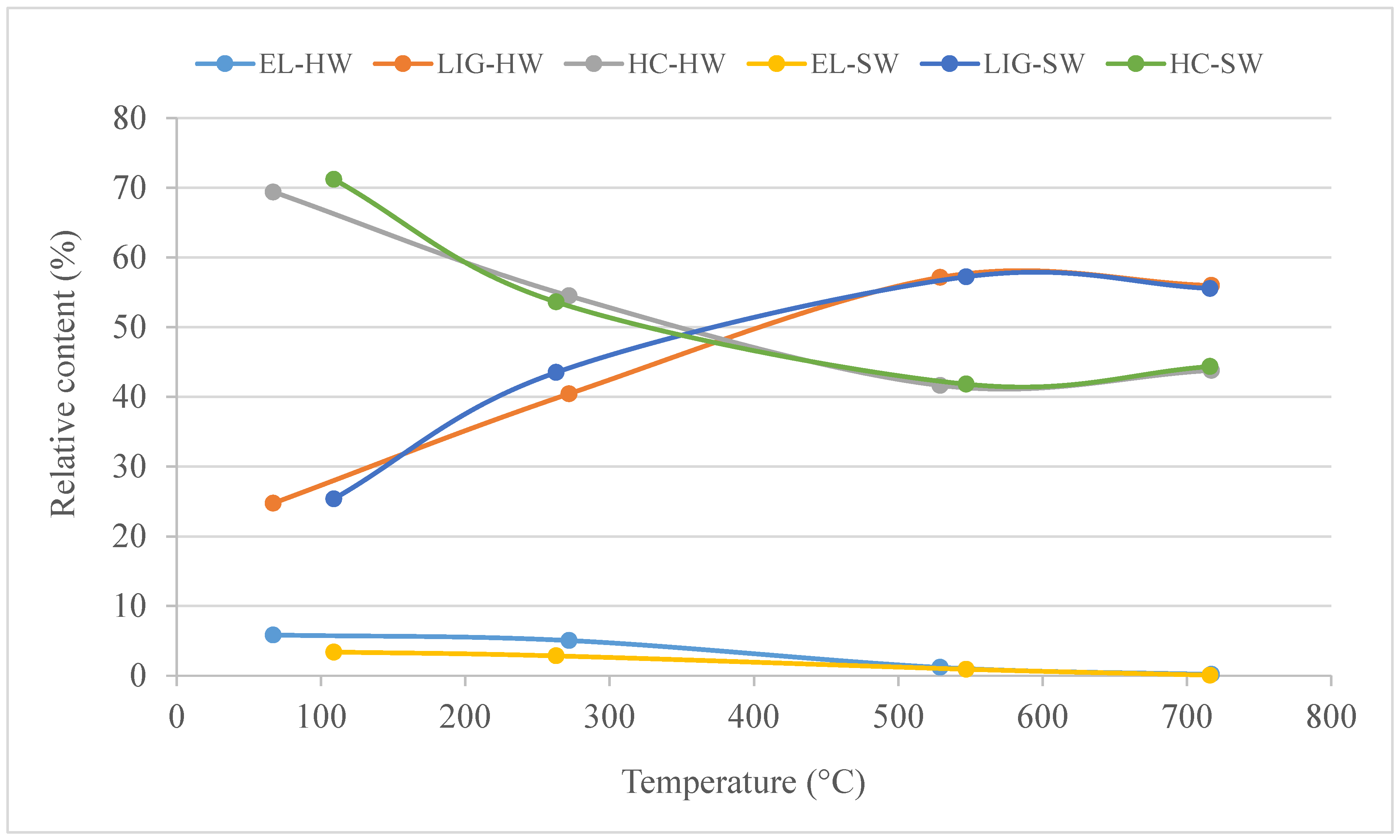
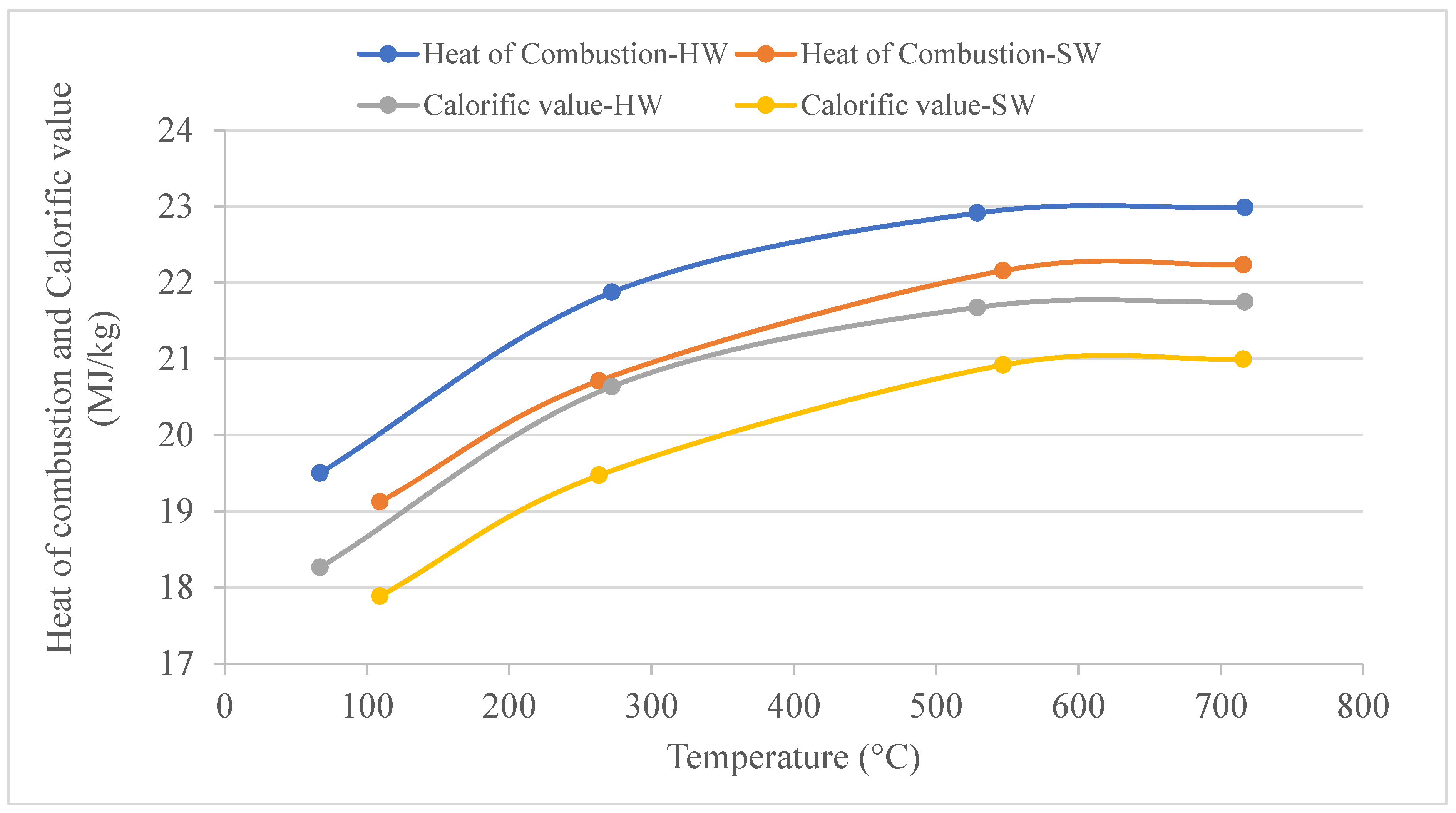

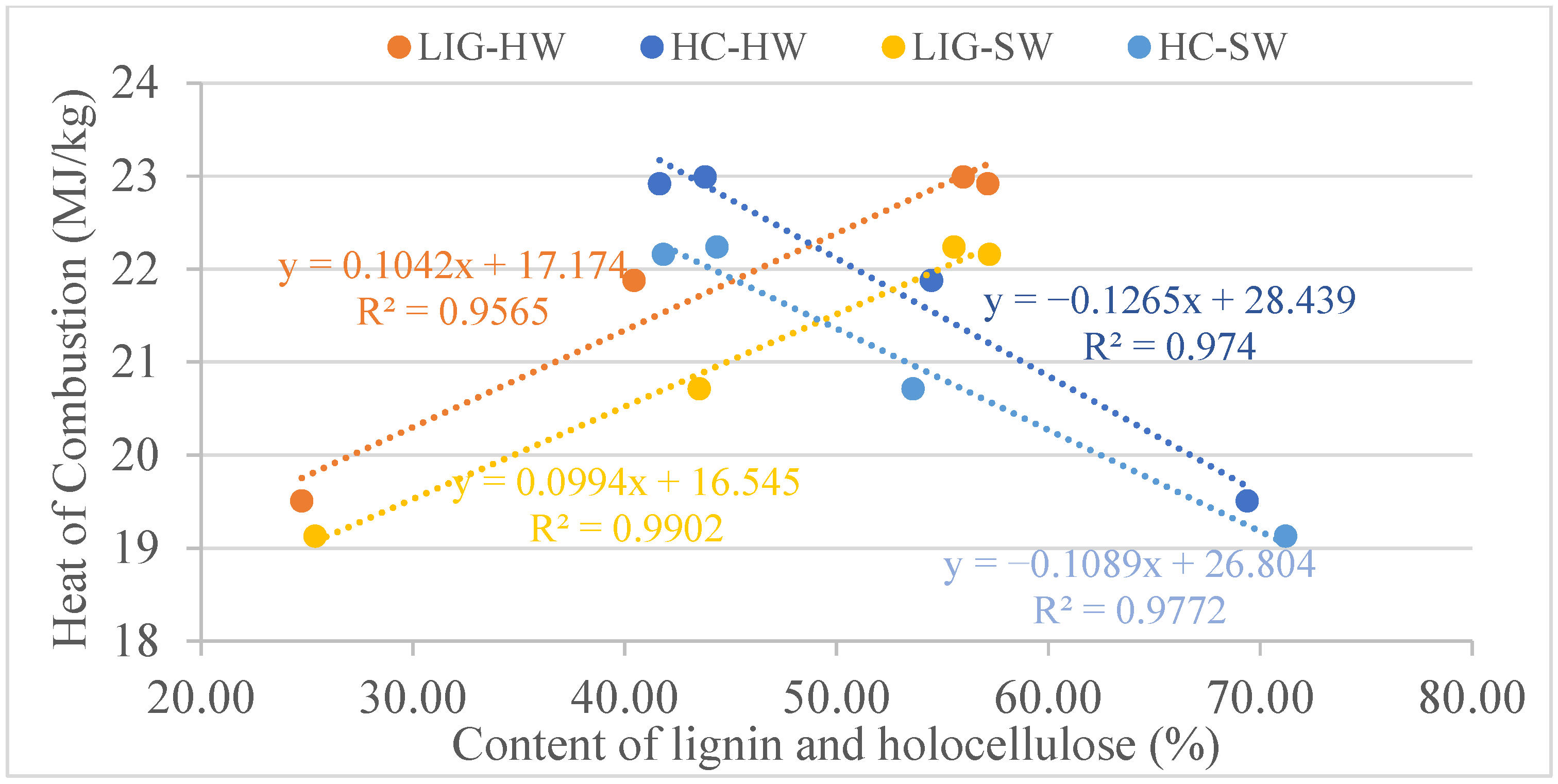
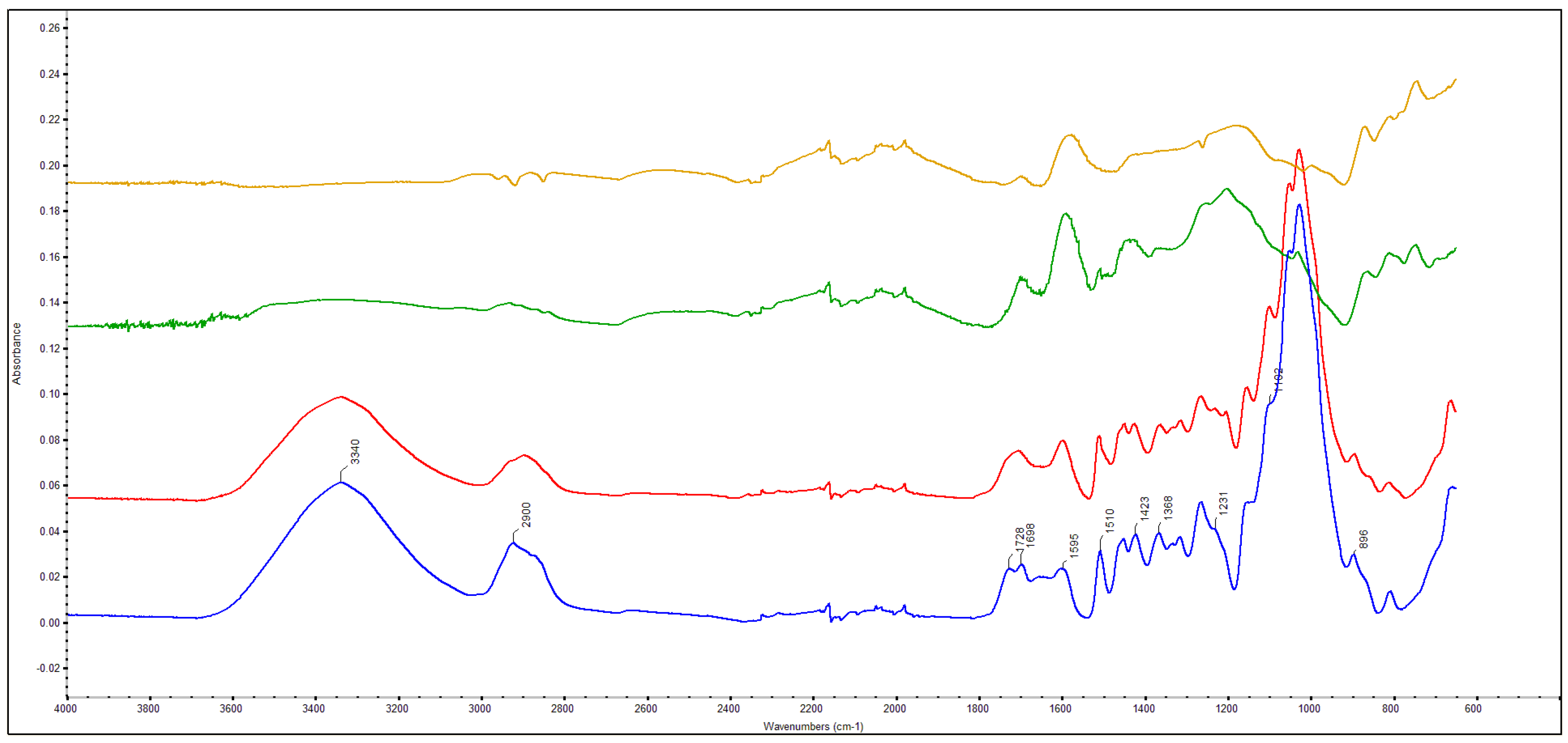
| Distance from the Exposed Side [mm] | Sample 50S/140H [mm·min−1] | Sample 20S/170H [mm·min−1] |
|---|---|---|
| 10 | 1.29 ± 0.15 | 3.16 ± 0.30 |
| 20 | 1.14 ± 0.09 | 1.90 ± 0.18 |
| 30 | 0.99 ± 0.05 | 1.08 ± 0.06 |
| TC1 (°C) | TC2 (°C) | TC3 (°C) | TC4 (°C) | TC5 (°C) | |
|---|---|---|---|---|---|
| Sample 50S/140H | 739.4 | 716.4 | 546.7 | 262.9 | 108.8 |
| Sample 20S/170H | 743.1 | 716.7 | 529.0 | 271.9 | 67.1 |
Disclaimer/Publisher’s Note: The statements, opinions and data contained in all publications are solely those of the individual author(s) and contributor(s) and not of MDPI and/or the editor(s). MDPI and/or the editor(s) disclaim responsibility for any injury to people or property resulting from any ideas, methods, instructions or products referred to in the content. |
© 2024 by the authors. Licensee MDPI, Basel, Switzerland. This article is an open access article distributed under the terms and conditions of the Creative Commons Attribution (CC BY) license (https://creativecommons.org/licenses/by/4.0/).
Share and Cite
Dúbravská, K.; Kučerová, V.; Štefková, J.; Mišíková, O. Charring of and Chemical Changes in Historical Wood under Thermal Loading. Forests 2024, 15, 1189. https://doi.org/10.3390/f15071189
Dúbravská K, Kučerová V, Štefková J, Mišíková O. Charring of and Chemical Changes in Historical Wood under Thermal Loading. Forests. 2024; 15(7):1189. https://doi.org/10.3390/f15071189
Chicago/Turabian StyleDúbravská, Katarína, Viera Kučerová, Jaroslava Štefková, and Ol’ga Mišíková. 2024. "Charring of and Chemical Changes in Historical Wood under Thermal Loading" Forests 15, no. 7: 1189. https://doi.org/10.3390/f15071189





